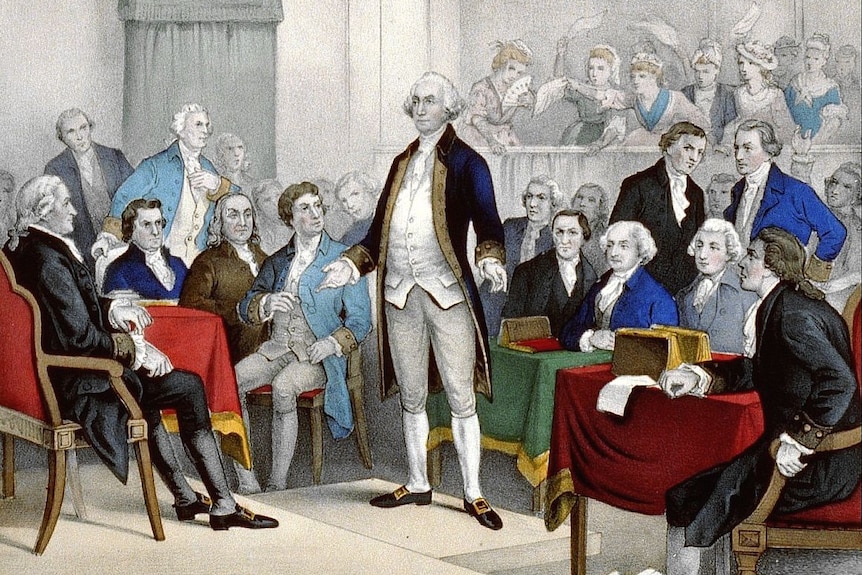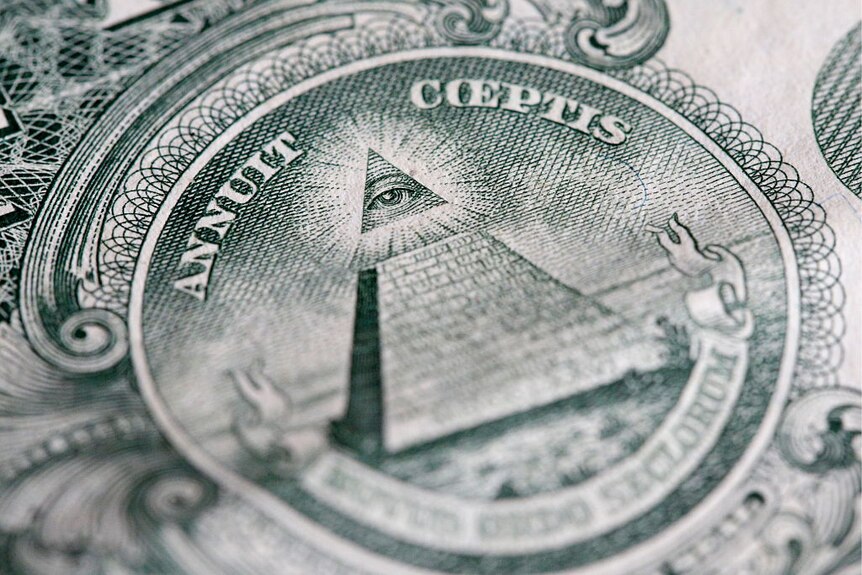Lizard people, the Illuminati and the CIA: How conspiracy theories thrive on fear
History has shown that, in times of uncertainty, people often like to jump to their own conclusions.
This is how conspiracy theories are born, says US author and cultural historian Colin Dickey.
Anxiety, paranoia, loneliness and a yearning for control in often uncontrollable circumstances all lead to conspiracy theories’ proliferation, he tells ABC RN’s Late Night Live.
And yet, while social media may have accelerated their accessibility, society’s obsession with them began long before the rise of the internet.
Fear and early conspiracy theories
Conspiracy theories in the US can be traced back hundreds of years, says Dr Dickey, whose latest book is Under the Eye of Power: How Fear of Secret Societies Shapes American Democracy.
“From the very birth of democracy [in the US], there was this idea that there were secret saboteur foreign agents and seditious spies,” he says.
“And it [created] this anxiety that quickly shaded into paranoia in Americans.”
Dr Dickey says during the US War of Independence — which was fought between North American colonists and Great Britain from 1775 to 1783 — some colonists believed the war was being secretly orchestrated by the French to divide and conquer Great Britain.
“That’s just one of the many conspiracy theories that floated around from the very beginning,” he says.

But University of Florida professor Victoria Pagan, who researches conspiracy theories in the ancient Roman world, says it goes back even further. She says as early as 331 BC, during the spread of an unknown plague, there’s a record of a health-related conspiracy theory in ancient Rome, which claimed a ring of women were poisoning people.
Similarly when the bubonic plague was taking hold across the world, a 14th-century conspiracy theory maintained by some in Europe claimed that Jews were poisoning wells, Dr Pagan explains.
Often conspiracy theories are rooted in the fears of others, Dr Dickey says.
For example, it was partly also out of fear of Chinese and Russian communists that the FBI and the CIA was formed, he says, adding that this fear led to an obscure project called MK-ULTRA.
“The CIA were worried that the Chinese had sort of discovered some kind of mind control drug and so they wanted to get caught up,” he says.
So they started experimenting with these drugs on unwitting American citizens, which he says “accomplished nothing scientifically”.
It backfired spectacularly. Following revelations that the US government was “secretly dosing people with LSD to experiment on them”, and also “spying on Martin Luther King”, the US government began to be seen as the source of conspiracies, rather than the target, Dr Dickey says.
The ‘eye’
Another example of a conspiracy theory that has gotten out of control is the one that surrounds the Eye of Providence, a common Christian symbol that appeared on the US one dollar bill in 1862.
The symbol was also used by the Freemasons, a fraternal organisation dating to the 14th century. The iconic triangular symbol, with an eye set in the middle, has contributed a number of conspiracy theories, Dr Dickey says.

“There’s nothing malevolent or nefarious about it. But the thing about these symbols is they linger on much longer than their actual meaning does,” he says.
Dr Dickey says in the last six to seven decades people began to associate the symbol with the Illuminati, a group that some conspiracy theorists believe controls the world’s affairs.
The Bavarian Illuminati, which ran between 1776 and 1786, was originally a small secret society opposed to religious influence on society. However, some conspiracy theories maintain that the Illuminati still exists, and has branched out to seize power around the world.
Who is at risk of believing?
Researchers have long theorised about the type of person who gravitates toward conspiracy theories.
Some studies suggest that people with an intuitive rather than analytical mindset are more likely to believe them, or that having a lack of education and being able to question and test the accuracy of information, plays a role too.
But no one is entirely immune to them, says Jolanda Jetten, the head of the School of Psychology at the University of Queensland.
And she says conspiracy theories are “just as rife here in Australia, as in the US”, particularly after the COVID-19 lockdowns.
Research can’t sufficiently explain why, particularly in recent times of uncertainty, “you suddenly have so many people embracing these conspiracy theories”, she says.
However there is often a common element between those who go furthest down conspiracy rabbit holes.
They are often “quite lonely people”, Professor Jetten says.
“They’re often at the margins of society, they have lower status positions. And by actually believing these conspiracy theories online, and having others who believe them too, you create a bit of a community, and you actually set yourself apart in a positive way because you know things that the rest of us don’t.”
The fallout of uncertainty

“If there’s something that we all fear, [it’s] uncertainty,” Professor Jetten says.
And, for some, conspiracy theories can help to deal with it.
“If there’s instability, or if there are massive events that happen that we don’t have explanations for, conspiracy theories are often something that can help to make sense of the world,” she says.
“It helps us or at least gives us the idea that we regain a bit of control in a world that seems to be out of control.”
Dr Dickey agrees.
He says a conspiracy theory can offer the illusion of a sense of order, and “even if that order seems malevolent or terrifying, it’s still more comforting than the idea of chaos and randomness”.
He estimates that more than half of the American population believes in some sort of conspiracy theory.
“Depending on how you ask the questions, somewhere between 50 and 75 per cent of Americans will agree to at least one statement that is largely accepted to be a conspiracy theory,” he says.
He cites as examples the idea “that 9/11 [the 2001 terrorist attacks in New York] was an inside job — that’s a popular one”, and also the “lizard people” theory, which is a belief that an alien race of reptilians are behind the global elites.
Protecting truth
Axel Bruns, a professor in the Digital Media Research Centre at the Queensland University of Technology, has witnessed conspiracy theories trickle down to Australia from the US.
In 2020, he was involved in a research project that looked at the spread of disinformation via social media at the start of the COVID-19 pandemic, with a particular focus on 5G mobile phone technology conspiracy theories.
The 5G theories pre-existed the pandemic, but then “cross-fertilised with literally everything”, he says.
“The Illuminati, the Antichrist, Bill Gates, [Hungarian-American businessman] George Soros, the Great Reset, the UN — anything else, basically, that you could think of, was rolled into this … cluster of conspiracy theories, that didn’t really need to make sense.”
Professor Bruns says social media platforms need to do more to stop the spread of conspiracy theories.
He acknowledges it’s a tough job and says there’s an “ongoing arms race” between the platforms and the people who seek to disinform.
“I’ve got some sympathy for [the platforms] in dealing with all of this because now we’re in this ongoing maelstrom of disinformation on all sorts of topics. And we’ve seen that with the Voice campaign at the moment as well,” he says.
But he doesn’t let platforms off the hook.
Professor Bruns says they should do more, and there’s at least one clear course of action: de-platforming (deleting or banning the accounts of) prominent figures who share conspiracy theories or misinformation.
“De-platforming works. It doesn’t remove the information altogether. It doesn’t completely cut off the flow of problematic information … but it reduces the visibility and it limits the access to that problematic content quite substantially,” he says.
“So it protects at least the bulk of the population reasonably well.”
RN in your inbox
Get more stories that go beyond the news cycle with our weekly newsletter.


